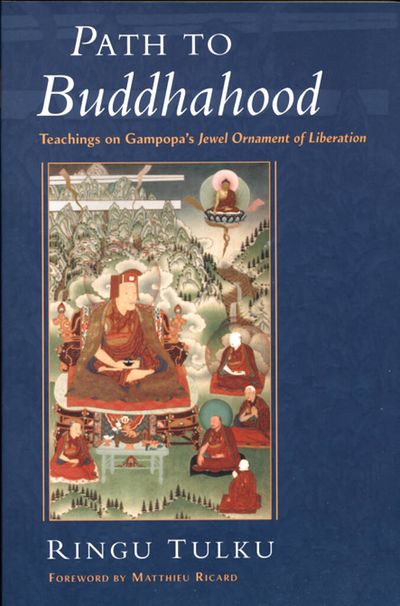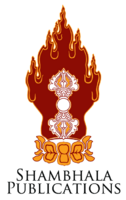Path to Buddhahood: Teachings on Gampopa's Jewel Ornament of Liberation
No edit summary |
No edit summary |
||
| Line 1: | Line 1: | ||
{{Book | {{Book | ||
|TileDescription=Teachings by the contemporary Tibetan teacher Ringu Tulku on Gampopa's beloved work on the stages of the path to enlightenment. | |TileDescription=Teachings by the contemporary Tibetan teacher Ringu Tulku on Gampopa's beloved work on the stages of the path to enlightenment. | ||
|BookPerson={{Book-person | |BookPerson={{Book-person | ||
| Line 22: | Line 21: | ||
|BookEssay=====The Text==== | |BookEssay=====The Text==== | ||
The Dagpo Tarjen<ref>1 Dvag po thar rgyan.</ref> or The Jewel Ornament | The Dagpo Tarjen<ref>1 Dvag po thar rgyan.</ref> or The Jewel Ornament of Liberation<ref>2 The Dagpo Tarjen was first translated into English by Herbert V. Guenther under the title The Jewel Ornament of Liberation (Berkeley: Shambhala, 1971). It was subsequently translated by Ken and Katia Holmes as Gems of Dharma, Jewels of Freedom (Forres, Scotland: Altea Publishing, 1995). A third translation, by Khenpo Konchog Gyaltsen Rinpoche, has been published under the original title, The Jewel Ornament of Liberation (Ithaca, N.Y.: Snow Lion Publications, 1998). </ref> of Gampopa is one of the most important texts of Tibetan Buddhism. In the Kagyu<ref>3 The Kagyu or Kagyupa (bka' brgyud pa) is one of the four main schools of Tibetan Buddhism. The other three are Nyingma (rnying ma), Gelug (dge lugs), and Sakya (sa skya).</ref> tradition it is the main text used in the instruction of monks. It is sometimes referred to as the "merging of the two streams" because Gampopa here combines two traditions or currents of Dharma teachings, that of the Mahayana Kadampa<ref>4 The Kadampa (bka' gdams pa) tradition traces its origin to the Mahayana (Great Vehicle) teachings of Atisha from the lineage of Nagarjuna and Asanga. It no longer exists as a separate tradition but has been incorporated into the four major contemporary schools of Tibetan Buddhism.</ref> tradition and that of the tantric Mahamudra<ref>5 The yogic experiential tradition from the lineage of the Indian panditas Tilopa and Naropa and from them to Marpa and Milarepa. Mahamudra (literally, "great seal") is the highest teaching of the Kagyu tradition. </ref> tradition. | ||
Gampopa's teachings brought these two traditions together in such a way that they could be practiced together as one experience. They quickly became one of the most important and effective foundation texts used in the teaching of Buddhism in Tibet from the eleventh century onward. The whole Kagyu tradition is based mainly on this teaching. | Gampopa's teachings brought these two traditions together in such a way that they could be practiced together as one experience. They quickly became one of the most important and effective foundation texts used in the teaching of Buddhism in Tibet from the eleventh century onward. The whole Kagyu tradition is based mainly on this teaching. | ||
| Line 93: | Line 92: | ||
|AddRelatedTab=No | |AddRelatedTab=No | ||
|PostStatus=Needs Copy Editing | |PostStatus=Needs Copy Editing | ||
|BookParentPage=Library | |||
}} | }} | ||
Revision as of 17:13, 18 November 2019
The Jewel Ornament of Liberation is regarded by all Tibetan Buddhist schools as one of the most inspiring and comprehensive works of the tradition. Written by Gampopa (born 1079 CE), the main spiritual son of the great hermit Milarepa, this important text lays out the stages of the Buddhist path and explains how an enlightened attitude is strengthened by practicing the six perfections of generosity, discipline, patience, exertion, meditation, and knowledge. (Source: Shambhala Publications)
| Citation | Ringu Tulku Rinpoche. Path to Buddhahood: Teachings on Gampopa's Jewel Ornament of Liberation. Edited by Maggy Jones, Briona Nic Dhiarmada, and Corinne Segers. Boston: Shambhala Publications, 2003. Originally published in French as Et si vous m'expliquiez le bouddhisme? Paris: Nil Editions, 2001. |
|---|---|
- 1 Dvag po thar rgyan.
- 2 The Dagpo Tarjen was first translated into English by Herbert V. Guenther under the title The Jewel Ornament of Liberation (Berkeley: Shambhala, 1971). It was subsequently translated by Ken and Katia Holmes as Gems of Dharma, Jewels of Freedom (Forres, Scotland: Altea Publishing, 1995). A third translation, by Khenpo Konchog Gyaltsen Rinpoche, has been published under the original title, The Jewel Ornament of Liberation (Ithaca, N.Y.: Snow Lion Publications, 1998).
- 3 The Kagyu or Kagyupa (bka' brgyud pa) is one of the four main schools of Tibetan Buddhism. The other three are Nyingma (rnying ma), Gelug (dge lugs), and Sakya (sa skya).
- 4 The Kadampa (bka' gdams pa) tradition traces its origin to the Mahayana (Great Vehicle) teachings of Atisha from the lineage of Nagarjuna and Asanga. It no longer exists as a separate tradition but has been incorporated into the four major contemporary schools of Tibetan Buddhism.
- 5 The yogic experiential tradition from the lineage of the Indian panditas Tilopa and Naropa and from them to Marpa and Milarepa. Mahamudra (literally, "great seal") is the highest teaching of the Kagyu tradition.
- 6 A geshe (dge bshes) is a scholar with a profound knowledge of the sutras and the Buddhist teachings.
- 7 Central Tibet.
- 8 A fuller account of Gampopa's meeting and relationship with Milarepa can be found in Garma C. C. Chang, trans., The Hundred Thousand Songs of Milarepa (New Hyde Park: University Books, 1962). See also Jampa Mackenzie Stewart, The Life of Gampopa (Ithaca, N.Y.: Snow Lion Publications, 1995).



